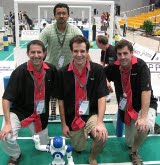Practical Vision-Based Monte Carlo Localization on a Legged Robot
Practical Vision-Based Monte Carlo Localization on a Legged Robot.
Mohan
Sridharan, Gregory Kuhlmann, and Peter
Stone.
In IEEE International Conference on Robotics and Automation, April 2005.
ICRA
2005
Download
[PDF]217.6kB [postscript]2.0MB [slides.pdf]2.5MB
Abstract
Mobile robot localization, the ability of a robot to determine its global position and orientation, continues to be a major research focus in robotics. In most past cases, such localization has been studied on wheeled robots with range-finding sensors such as sonar or lasers. In this paper, we consider the more challenging scenario of a legged robot localizing with a limited field-of-view camera as its primary sensory input. We begin with a baseline implementation adapted from the literature that provides a reasonable level of competence, but that exhibits some weaknesses in real-world tests. We propose a series of practical enhancements designed to improve the robot's sensory and actuator models that enable our robots to achieve a $50\%$ improvement in localization accuracy over the baseline implementation. We go on to demonstrate how the accuracy improvement is even more dramatic when the robot is subjected to large unmodeled movements. These enhancements are each individually straightforward, but together they provide a roadmap for avoiding potential pitfalls when implementing Monte Carlo Localization on vision-based and/or legged robots.
BibTeX Entry
@InProceedings(ICRA2005-localization,
author="Mohan Sridharan and Gregory Kuhlmann and Peter Stone",
title="Practical Vision-Based Monte Carlo Localization on a Legged Robot",
booktitle="{IEEE} International Conference on Robotics and Automation",
month="April",year="2005",
abstract={
Mobile robot localization, the ability of a robot to
determine its global position and orientation,
continues to be a major research focus in robotics.
In most past cases, such localization has been
studied on wheeled robots with range-finding sensors
such as sonar or lasers. In this paper, we consider
the more challenging scenario of a legged robot
localizing with a limited field-of-view camera as its
primary sensory input. We begin with a
\emph{baseline} implementation adapted from the
literature that provides a reasonable level of
competence, but that exhibits some weaknesses in
real-world tests. We propose a series of practical
enhancements designed to improve the robot's sensory
and actuator models that enable our robots to achieve
a $50\%$ improvement in localization accuracy over
the baseline implementation. We go on to demonstrate
how the accuracy improvement is even more dramatic
when the robot is subjected to large unmodeled
movements. These enhancements are each individually
straightforward, but together they provide a roadmap
for avoiding potential pitfalls when implementing
Monte Carlo Localization on vision-based and/or
legged robots.
},
)



